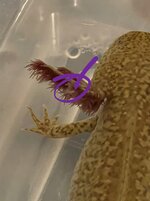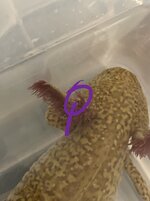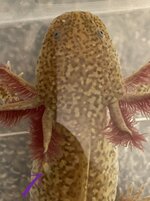kaypluslee
New member
My 9 m/o, 11.5in axolotl has developed what I believe to be a small bit of fungus on the tip of one of its gills. I have been using Indian Almond Leaves in the tub for the last few days, but have seen no improvement. Upon researching how to further treat this ailment, I came across tea baths and salt baths. Personally I am a bit scared of salt baths, I feel like the consequences of messing up a salt bath could be much more severe than with a tea bath, so I opted to try a tea bath.
From what I read, you just need 1 tea bag with black tea as the only ingredient, and about 2.5 gallons of water to house the axolotl to make for a good ratio. I purchased some organic English breakfast tea, the ingredients just listed “a blend of black teas”, so I assumed it was safe to use. It does have caffeine.
I don’t think I had a very good experience, which is why I am asking for advice going forward.
I have three tubs. One the axolotl was occupying, one for the tea, and one for after the tea. I filled the two unoccupied tubs with about 2.5 gallons of water and treated with Prime, and stuck both tubs in the fridge so they would get down to temperature (occupied tub was 59 degrees Fahrenheit). I used my Keurig to brew the tea in an 8oz mug, and after letting it soak for about 15 mins, dumped it into the tea tub. After some brainstorming, I think that this is where I may have gone wrong, as the water reservoir for the Keurig is obviously was not treated with Prime, and I dumped the 8oz untreated brewed tea water into the 2.5 gallons of treated water (treated 15 mins prior).
About 5 minutes after combining the tea and the treated water and checking the temperature of the “tea tub” (58.8 F), I added my axolotl. The stress was apparent after about 2 minutes. My axolotl began shaking its head violently every 20-30ish seconds—like a strong, quick nod to one side, while pacing around the tub. At one point it came up for air around the 6 minute mark. The last straw for me was when it started trying to itch its gills with its back legs, around the 10 minute mark. I immediately pulled it out of the tea bath and into the second tub of fresh water I had prepared. I had planned for a 15 minute tea bath, but the behavior really concerned me.
My axolotl appears to have recovered well enough. The gills to appear to have been affected, they seem… sticky? Clumpy? The fungus gill worse than the others. I have not seen the gill itching or head shaking since putting it into the fresh water tub. The fungus is still on the affected gill.
So, my question is, is this a typical tea bath experience?? If not, where did I go wrong or what can I do to improve? I feel strongly that if I messed up anywhere, it was adding the tea after I had treated the water, and not before, but I am not sure.
Secondly, I have API freshwater aquarium salt readily available to do a salt bath. I am just very hesitant to do so, especially after this tea bath experience. I have read that salt baths are the preferred method to treat fungus though, so I know this may be the better option going forward. How much salt would you need to use for a tub with about 2.5 gallons of water? Do you just follow the instructions on the box and adjust accordingly? What works for you? And importantly, what is typical axolotl behavior during a salt bath, in your experience? I did see a thread about giving salt baths, but I’d like any recommendations you have to offer.
Also, what could have caused the fungus? My axolotl has never lived in a tank with a filter (despite months of trying to cycle a tank), so I change 100% of the water and switch tubs daily. Water is treated with Prime. The temperature of the water is usually between 59 and 64 F. I have an air stone and a thermometer probe in the tub at all times. Feeding time is before tub and water change, so no food is left for more than 20 mins. Since noticing the fungus about 5 days ago, I have made sure to really wipe down the tub before and after spraying it out with hot water and giving a final rinse, thought I have always sprayed it out. I am also going to start wiping down the air stone and probe, just in case I am missing something. I have never had this problem in the 5 months I have owned my axolotl, so I’m not sure what could be the culprit.
Thank you for any advice!
From what I read, you just need 1 tea bag with black tea as the only ingredient, and about 2.5 gallons of water to house the axolotl to make for a good ratio. I purchased some organic English breakfast tea, the ingredients just listed “a blend of black teas”, so I assumed it was safe to use. It does have caffeine.
I don’t think I had a very good experience, which is why I am asking for advice going forward.
I have three tubs. One the axolotl was occupying, one for the tea, and one for after the tea. I filled the two unoccupied tubs with about 2.5 gallons of water and treated with Prime, and stuck both tubs in the fridge so they would get down to temperature (occupied tub was 59 degrees Fahrenheit). I used my Keurig to brew the tea in an 8oz mug, and after letting it soak for about 15 mins, dumped it into the tea tub. After some brainstorming, I think that this is where I may have gone wrong, as the water reservoir for the Keurig is obviously was not treated with Prime, and I dumped the 8oz untreated brewed tea water into the 2.5 gallons of treated water (treated 15 mins prior).
About 5 minutes after combining the tea and the treated water and checking the temperature of the “tea tub” (58.8 F), I added my axolotl. The stress was apparent after about 2 minutes. My axolotl began shaking its head violently every 20-30ish seconds—like a strong, quick nod to one side, while pacing around the tub. At one point it came up for air around the 6 minute mark. The last straw for me was when it started trying to itch its gills with its back legs, around the 10 minute mark. I immediately pulled it out of the tea bath and into the second tub of fresh water I had prepared. I had planned for a 15 minute tea bath, but the behavior really concerned me.
My axolotl appears to have recovered well enough. The gills to appear to have been affected, they seem… sticky? Clumpy? The fungus gill worse than the others. I have not seen the gill itching or head shaking since putting it into the fresh water tub. The fungus is still on the affected gill.
So, my question is, is this a typical tea bath experience?? If not, where did I go wrong or what can I do to improve? I feel strongly that if I messed up anywhere, it was adding the tea after I had treated the water, and not before, but I am not sure.
Secondly, I have API freshwater aquarium salt readily available to do a salt bath. I am just very hesitant to do so, especially after this tea bath experience. I have read that salt baths are the preferred method to treat fungus though, so I know this may be the better option going forward. How much salt would you need to use for a tub with about 2.5 gallons of water? Do you just follow the instructions on the box and adjust accordingly? What works for you? And importantly, what is typical axolotl behavior during a salt bath, in your experience? I did see a thread about giving salt baths, but I’d like any recommendations you have to offer.
Also, what could have caused the fungus? My axolotl has never lived in a tank with a filter (despite months of trying to cycle a tank), so I change 100% of the water and switch tubs daily. Water is treated with Prime. The temperature of the water is usually between 59 and 64 F. I have an air stone and a thermometer probe in the tub at all times. Feeding time is before tub and water change, so no food is left for more than 20 mins. Since noticing the fungus about 5 days ago, I have made sure to really wipe down the tub before and after spraying it out with hot water and giving a final rinse, thought I have always sprayed it out. I am also going to start wiping down the air stone and probe, just in case I am missing something. I have never had this problem in the 5 months I have owned my axolotl, so I’m not sure what could be the culprit.
Thank you for any advice!




